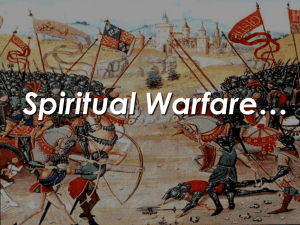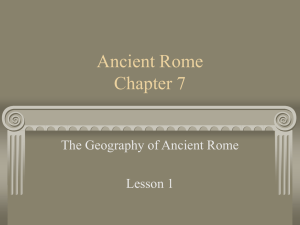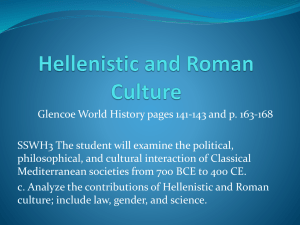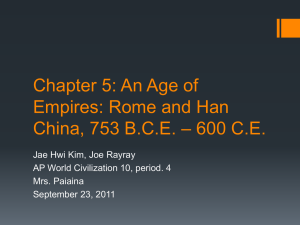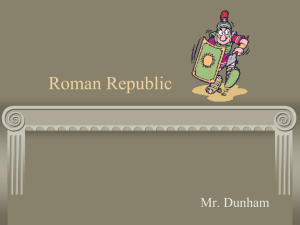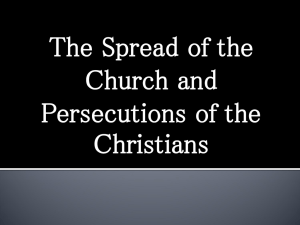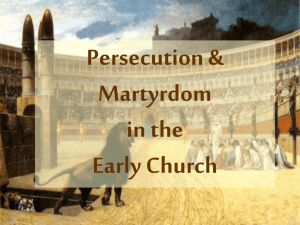Senior Chapter 4 – Version 1
advertisement
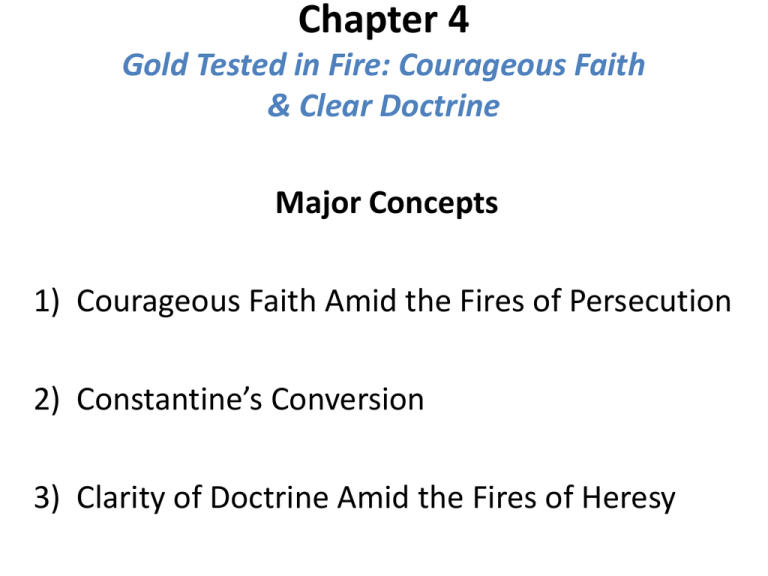
Chapter 4 Gold Tested in Fire: Courageous Faith & Clear Doctrine Major Concepts 1) Courageous Faith Amid the Fires of Persecution 2) Constantine’s Conversion 3) Clarity of Doctrine Amid the Fires of Heresy From a letter written by a Christian who survived persecution, written in the year 177 C.E.: “There can be no adequate description, either in word or in writing of the magnitude of the suffering here, of the animosity of the pagans towards the saints, or of the steadfastness of the blessed martyrs ….” Courageous Faith Amid the Fires of Persecution • Governments under pressure, either because of external threats or internal dissent, often revert to victimizing some minority for their difficulties • Rome from 100 CE to about 300 CE was under significant external threats from barbarians, some of whom had previously been Roman allies, ex. the Goths • Rome continued to forge alliances only to betray their allies or fail to deliver on promises made • The ‘Roman” army was no longer largely Roman made up of citizen soldiers. Instead it was made up of mercenaries drawn from many cultures with minimal allegiance to Rome itself • The Empire had grown so large, and distance took so long to cover, that maintaining centralized authority and control in Rome was becoming impossible • The East, largely Egypt, were often allowed their own control • Emperor Diocletian eventually split the Empire into 3 totally separate parts in the 3rd century • Inside the Empire, dissension rose as Emperors were often absent from Rome fighting wars on foreign soil leaving the city to decline • Disease, shortages of food and a lack of troops to keep the peace led the rich to leave the city leaving the poor to fend for themselves • Like most cosmopolitan Empires, the Empire and city of Rome were now largely populated by non-Romans whose loyalty was one of convenience • The presence of large numbers of slaves throughout the Empire, many trained to fight as gladiators, added to the tension • Aqueducts started to fail to deliver water, sewage backed up into the streets, crime rose as people would do anything to feed their families, made the city of Rome more like the barbarian cities they were used to conquering • Emperors came and went with little or no management ability or interest • Emperors increasing were assassinated by their own guards, the Praetorian Guards, with their successors picked by the same soldiers • The decadence of the Emperors became legendary in their own time, ex. Emperor Nero played his fiddled as Rome burned • And here was the vulnerable followers of this new religion, the “Christians,” disliked by the Roman and Jewish priests alike, with no political patronage, available as the people who could be blamed for Rome’s troubles • Christians would not give homage to Roman gods, not even the Emperor who saw himself as a god, thereby destroying Roman unity and demonstrating a lack of patriotism • Christians refused to serve in the Roman army • The Emperor’s solution: blame the Christians and send them to the Coliseum: – To fight gladiators without their own weapons – To be fed to live, hungry animals such as lions and bears – To be covered in tar and used as human torches to light the Emperor’s gardens at night – If Roman citizens, to be beheaded publically – To be crucified en masse in the Coliseum: men, women and children – and, human/animal sexual bestiality • Show “Senior Video Clips” # 1-5 • And this persecution was not limited to Rome proper • It was by order of the Emperor carried out throughout the Roman Empire • Christians found no refuge anywhere and yet converts not only continued, but increased in number • Converts found in the faith of the martyrs something missing in their own lives • Church fathers also allowed early Christians to deny their faith in order to save their lives. Understanding the faith amid Persecution • Christians were still trying to come to grips with question of who Jesus actually was • Different beliefs even created divisions with in the early decentralized communities • The combination of internal struggles within Christianity and persecution from without created “the gold test in fire” • Some Christians could not face martyrdom and had to renounce the faith to stay alive • Christians who had renounced their faith (apostates), or sacrificed to idols, in order to save their lives, were allowed to rejoin the church after: – a process of public penance – and, a ritual of re-entry • Apostasy is the formal disaffiliation from, or abandonment or renunciation of a religion by a person. One who commits apostasy apostatizes and is an apostate. These terms have a pejorative implication in everyday use. Key Terms: Apostate, Heresy and Blasphemy An apostate differs from a heretic – a person who espouses heresy. Heresy is a controversial or novel change to a system of beliefs, especially a religion, that conflicts with established dogma. It is distinct from apostasy, which is the formal denunciation of one's religion, principles or cause, and blasphemy, which is irreverence toward religion. • Christianity was too new a religion in the 1st thru 3rd centuries for heresies to have had time to develop. • Blasphemy might have come in the manner of graffiti drawn by critics of the religion, but it’s not likely to have come from within the church itself. • But apostasy was a problem as people tried to be faithful, but bowed to the “life or death” pressure of persecution. • An apostate's performance of public penance and participation in a rite of re-entry into the church were the roots of what came to be known as the Sacrament of Reconciliation. • In the teaching of the Catholic Church, the Sacrament of Penance (commonly called Confession, Reconciliation or Penance) is the method given by Christ to the Church by which individual men and women may be freed from sins committed after receiving Baptism, which itself (Baptism) frees the penitent from all previous sins. Not Everyone Was, or is, Cut Out to be a Martyr • A martyr is generally understood to be a person who chooses to suffer death rather than renounce religious principles. • No one knows for sure how many martyrs there were in the early church although historians believe it was probably a large number. • But if everyone had become a martyr there would have been no one left to continue the faith! • Read page 66 out loud in class Persecution can have the Opposite Effect from that Wanted by the Oppressors • Persecution can lead to a consolidation and solidification of the oppressed group • During the two centuries it was illegal to be Christian in the Roman Empire, new communities continued to begin and grow in Asia Minor, Syria, Greece, Italy and Rome itself, Gaul, Spain and the northern coast of Africa • For homework, read the section “Well-known” Early Martyrs on page 67 • Despite persecution, Church Structures and Roles Developed: – Election of a bishop at the local level – Deacons and Deaconesses – Before the fall of Jerusalem in 70 C.E., , the Bishop of Jerusalem was considered the most important – The Bishop of Rome them took primacy as the place where Peter (Jesus’ appointed head of His Church) had been martyred) as the “successor to St. Peter” – All were initially part-time & self-supporting • For homework, read pages 68 thru 72 • Christianity undergoes a revolution from a church of non-violent martyrs who were part of a growing Church, to a Church intertwined with the culture, politics, and wars of Europe for many centuries • For written homework, to be turned in tomorrow, answer the five Review questions on the bottom right of page 72.




